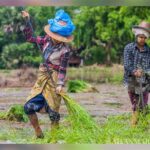
The British Impact on Myanmar By Hillary Htun (NEW YORK) MoeMaKa, 27th Sept 2022 Last year when I was taking World History, it was part of the required curriculum to learn about south, east, and southeast Asia. These regions had…
Tradition, History and Culture of Burma and Burmese people
Pagodas and What They Mean to Buddhists
Khin Myo Chit
Pagodas: Romance and Legend
It all began, long before I was old enough to understand that stupas and pagodas symbolize the great wisdom and compassion of the Buddha to whom we owe our way of life, our philosophy, our culture and above all, our fortitude that helps us to survive all trials that life has to offer.
My earliest memories are of the green wooded hills rising out of the wide flowing river Ayeyawady. On every hill top I saw one lone pagoda or a group of threes and fours, some gilded, others whitewashed and gleaming. Since I had many opportunities to make trips up and down the river, pagodas on hill tops remain one of my happiest recollections of childhood.
Of the first things I learned about pagodas nothing had to do with the intellectual side of Buddhism but all was full of colour and romance. Once, while we were crossing the river from Mandalay to Sagaing in a small flat-bottomed boat (it was long before the beautiful Inwa bridge was built) we headed towards the long dark range of thickly wooded hills, crested with shining pagodas, and the tinkling bells from their htis as the fretted wrought iron spires on top of the pagodas are called, chimed welcome to us. Colonnaded stair-ways zig-zagged through the flowering foliages. They looked so inviting that I could hardly wait to run up the steps and reach the pagodas up there.

by Khin Myo Chit
Of the many things that intrigue the visitor to the precincts of the Shwedagon Pagoda, nothing is so baffling and complicated as the figurines of mythical animals, each perched on its red signboard at the eight points of the compass.
Keeping the great stupa on the right, the visitor starts at the northeast comer, where the figure of the mythical garuna bird represents the sun, the ruling celestial body on Sunday. The unwary visitor probably does not have an inkling that he or she is being taken on a tour through the planetary regions, at least not yet.
A well-meaning friend may tell the visitor that the days of the week are assigned respectively to each point of the compass, each with its ruling planet or celestial body and its mythical symbol.
“But there are only seven days in the week. One point of the compass will be vacant,” the visitor ventures to comment; the visitor of course has not taken into account Myanmar ingenuity in taking liberties with the days of the week. The midweek day, Wednesday, is split into two parts so that the distribution is even.


Modern Burmese Poetry
by Maung Tha Noe
October 21, 2008
When the BBC asked me in a recent interview what books the youth in Burma today are reading, I told them our boys and girls are too busy looking for means of survival to bother about literature. The interviewer retorted to the effect that someone in a Rangoon bookshop had told her they do read computer books and economics books. I told her that computer books or books on business management are not literature, at least not imaginative literature. The young people today are not reading the kinds of books we used to read in our student days – books by Shwe-udaung or Bhamo Tin Aung, novels by D.H. Lawrence or George Orwell, or the Rubaiyat of Omar Khayyam or Mayakovskiy’s Cloud in Trousers.